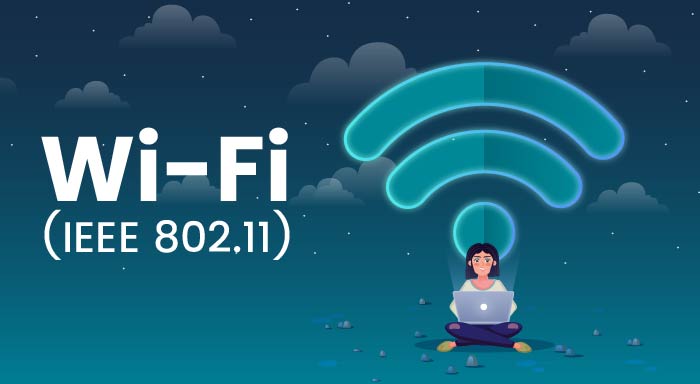Introduction
Nowadays Wi-Fi is as much a necessity in our everyday life just like electricity is needed to power homes and businesses. This stupendous technology supports our electronic existence and many of us are blissfully ignorant of it. In this blog, we will discuss one of the types of IoT communication protocols which is Wi-Fi(IEEE 802.11), knowing its history, working, generations, benefits security, and more.
What Is Wi-Fi (IEEE 802. 11)?
Technically, Wi-Fi is a way of passing data in wireless environments, through wireless local area networks. That is based on the IEEE 802. 11 standards, a group of procedures that enables different devices to communicate efficiently. These standards ensure that Wi-Fi devices produced by different end manufacturers are compatible. Although in everyday language we still use Wi-Fi and freely write it as Wi-Fi, IT specialists call it IEEE 802. 11.
Brief History of Wi-Fi
Wi-Fi was invented in the mid-1980s when the FCC identified some of the radio frequencies for public use. This decision led to the revolution of the wireless communication systems in the society. The first wireless networking standard became official in 1997; however, genuine interest began in 1999. In that year a faster standard was defined and the WIFi Alliance was created to make sure different devices would be compatible. Since then, there have been various generations of Wi-Fi each with enhanced speed and general performance.
How Wi-Fi Works
Let’s think of Wi-Fi as an invisible postal service; packets as postcards or letters, and routers and base stations as post offices. Your router is the post office because it sends out radio wave “letters” and an empty one takes data back. In the same way that your little post offices interpret these radio waves and convert them back into data, your devices do the same. This happens billions of times a second and as a result, there is constant knitting of information.
Wi-Fi typically operates on two main frequency bands: 2. The two frequencies include 4 GHz and 5 GHz. The 2. 4 GHz band has better coverage and is more vulnerable to interference while the 5 GHz band supports faster data rates but at a shorter distance.
Wi-Fi Standards and Generations
Nowadays, wireless technology as Wi-Fi has gone through several generations during the years. Quite simply, each new standard issued is expressed with a different numeration after 802. 11, has brought significant improvements:11, has brought significant improvements:
1. 802.11b (1999): It became the first established standard to be utilized in business.
2. 802.11a (1999): Intuitive, but with lower accuracy and reaction rate while having a shorter distance it activates at.
3. 802.11g (2003): It compiled features of ‘b’ and ‘a’.
4. 802.11n (2009): Implemented MIMO technology to improve its performance.
5. 802. 11ac (2014): Integrated gigabit speeds to wireless technology.
6. 802. 11ax (Wi-Fi 6, 2019): Built to cater to the Internet of Things reality.
7. 802. 11be (Wi-Fi 7, expected 2024): Claiming to offer mind-boggling speeds.
Every generation has expanded the possibilities of wireless Local Area Network services or WLANs.
Benefits of Wi-Fi
It is worth mentioning that Wi-Fi’s success is not only a result of the clever application of branding techniques. It offers tangible benefits that have revolutionized how we live and work:
1. Flexibility: Once more, it will be possible to forget about cables interfering while maneuvering, or being attached to a certain location.
2. Mobility: Be connected when you are in movement within your home or office.
3. Cost-effectiveness: The installation of the Wi-Fi network is sometimes more affordable than fixing the entire building with cables.
4. Scalability: As for adding new devices, this is not easier said than done – it is as simple as pie.
5. Versatility: From Smartphones, and smart TVs to smart fridges Wi-Fi brings all of it under its roof.
Also Read - Bluetooth Low Energy | Powering the IoT Revolution
Wi-Fi Security
Like all networks that transfer data through the air, security is a key component of Wi-Fi networks. Over the years, several security protocols have been developed to protect Wi-Fi networks:
1. WEP (Wired Equivalent Privacy): This first standard for security has been found to have some weaknesses hence becoming irrelevant at the moment.
2. WPA (Wi-Fi Protected Access): Somewhat better than WEP, but at the same time, it is already considered outdated.
3. WPA2: Currently the most used, is recommended for most people as it provides enough security.
4. WPA3: Current and even more secure than WPA2, more advanced protection against different kinds of attacks can be achieved.
Conclusion
From its humble beginnings to its current status as a critical infrastructure, Wi-Fi has come a long way. It's the invisible force that keeps our digital world spinning, enabling everything from remote work to streaming services. As we look to the future, Wi-Fi will undoubtedly continue to evolve, pushing the boundaries of what's possible in wireless communication.
Whether you're streaming your favorite show, working remotely, or simply browsing the web, Wi-Fi is the invisible force that keeps you connected to the digital world. By understanding this technology, we can better appreciate its impact on our daily lives and look forward to the exciting developments that lie ahead in the world of wireless connectivity.



